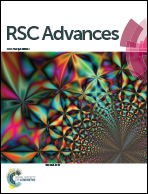Photocatalytic H2 generation over In2TiO5, Ni substituted In2TiO5 and NiTiO3 – a combined theoretical and experimental study
Abstract
We report here the role of Ni substitution in modifying the crystal structure, optical absorption properties and electronic properties of indium titanate, In2(1−x)Ni2xTiO5−δ (0.0 ≤ 2x ≤ 0.4) and its consequent effect on the photocatalytic properties for H2 generation. Rietveld refinement of observed XRD patterns of the titanates revealed that Ni2+ substitution has led to a decrease in lattice cell parameters and cell volume, contraction of InO6 octahedra and consequently improved charge carrier properties. Furthermore, the conduction band maximum (CBM) was found to be a hybrid state between Ni, Ti and In orbitals in 10% Ni-doped sample, which suggests that the photo-induced charges can be better transported in the substituted samples from zigzag chains of [·Ni–O–Ti⋯In–O–Ti----]. The UV-visible diffuse reflectance spectra exhibited that the band gap of the indium titanate phase decreased sequentially with an increase in the extent of Ni substitution. The underlying cause for band gap narrowing on Ni substitution was evaluated from plane wave based DFT calculations using the GGA + U approach. The decreasing order of photocatalytic activity (as a percentage of Ni substitution) for hydrogen generation from water–methanol mixture is as follows: 10% > 5% > indium titanate > 15% > 20%. The fall in activity below indium titanate coincided with the appearance of ilmenite NiTiO3 phase. Plane wave based DFT calculations performed on NiTiO3 revealed that strong intermixing of Ni-3d with O-2p orbitals occurred in the valence band of NiTiO3 and resulted in generation of a pseudo band gap of 0.3 eV at 1.4 eV below the Fermi level. This pseudo band gap might act as a hindrance and may contribute to weakening the intensity of the electronic transition due to Ni2+ → Ti4+ charge transfer. We propose here that an optimal concentration of 10% Ni substitution in indium titanate modifies the structural and electronic properties favorably leading to better photocatalytic activity by reducing the band gap, enhancing of the electron–hole separation and improving charge carrier properties.


 Please wait while we load your content...
Please wait while we load your content...